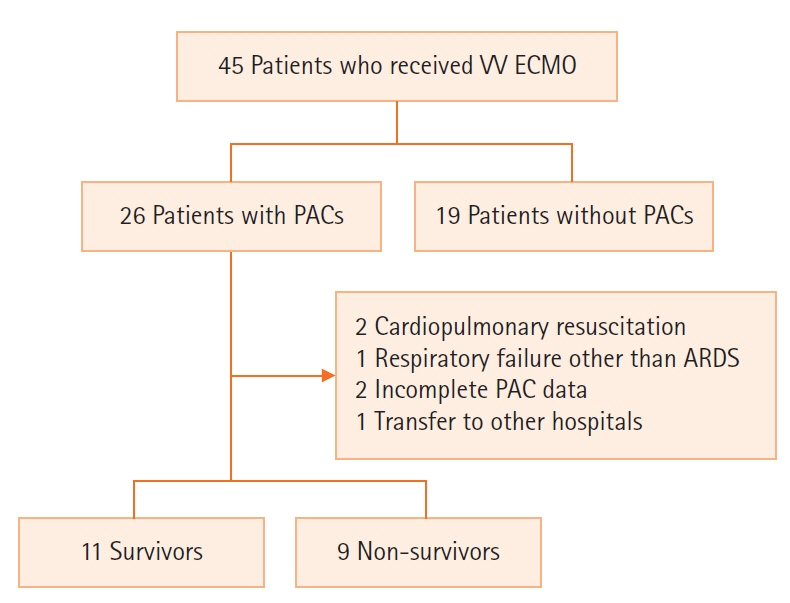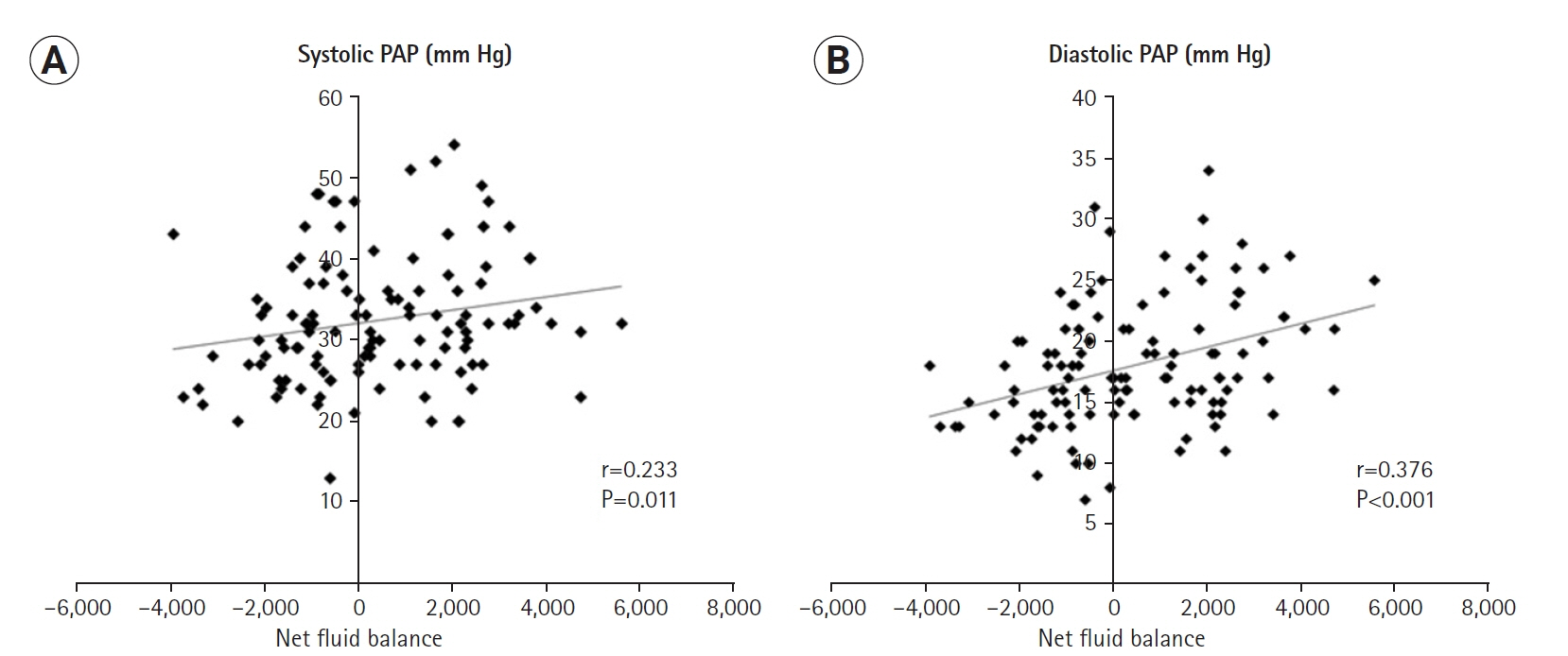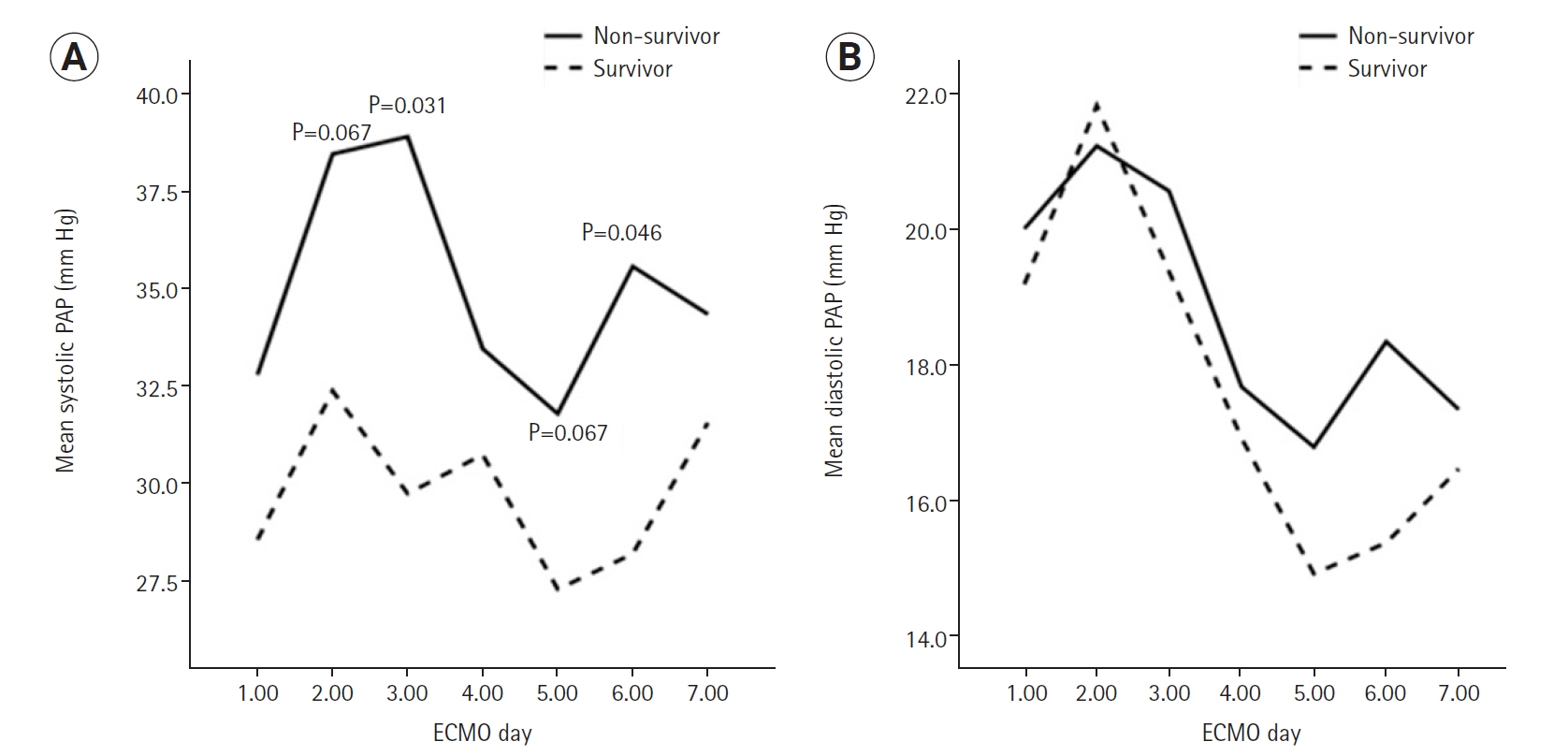Acute Crit Care.
2022 May;37(2):159-167. 10.4266/acc.2021.00927.
Association of pulmonary arterial pressure with volume status in patients with acute respiratory distress syndrome receiving extracorporeal membrane oxygenation
- Affiliations
-
- 1Department of Surgery, Hallym University Sacred Heart Hospital, Anyang, Korea
- 2Department of Cardiothoracic Surgery, Hallym University Sacred Heart Hospital, Anyang, Korea
- 3Department of Pulmonary, Allergy and Critical Care Medicine, Hallym University Sacred Heart Hospital, Anyang, Korea
- KMID: 2531672
- DOI: http://doi.org/10.4266/acc.2021.00927
Abstract
- Background
Data on pulmonary hemodynamic parameters in patients with acute respiratory distress syndrome (ARDS) receiving extracorporeal membrane oxygenation (ECMO) are scarce.
Methods
The associations between pulmonary artery catheter parameters for the first 7 days of ECMO, fluid balance, and hospital mortality were investigated in adult patients (aged ≥19 years) who received venovenous ECMO for refractory ARDS between 2015 and 2017.
Results
Twenty patients were finally included in the analysis (median age, 56.0 years; interquartile range, 45.5–68.0 years; female, n=10). A total of 140 values were collected for each parameter (i.e., 7 days×20 patients). Net fluid balance was weakly but significantly correlated with systolic and diastolic pulmonary arterial pressures (PAPs; r=0.233 and P=0.011; r=0.376 and P<0.001, respectively). Among the mechanical ventilation parameters, above positive end-expiratory pressure was correlated with systolic PAP (r=0.191 and P=0.025), and static compliance was negatively correlated with diastolic PAP (r=−0.169 and P=0.048). Non-survivors had significantly higher systolic PAPs than in survivors. However, in multivariate analysis, there was no significant association between mean systolic PAP and hospital mortality (odds ratio, 1.500; 95% confidence interval, 0.937–2.404; P=0.091).
Conclusions
Systolic PAP was weakly but significantly correlated with net fluid balance during the early ECMO period in patients with refractory ARDS receiving ECMO.
Keyword
Figure
Reference
-
1. Bull TM, Clark B, McFann K, Moss M; National Institutes of Health/National Heart, Lung, and Blood Institute ARDS Network. Pulmonary vascular dysfunction is associated with poor outcomes in patients with acute lung injury. Am J Respir Crit Care Med. 2010; 182:1123–8.
Article2. Ryan D, Frohlich S, McLoughlin P. Pulmonary vascular dysfunction in ARDS. Ann Intensive Care. 2014; 4:28.
Article3. Osman D, Monnet X, Castelain V, Anguel N, Warszawski J, Teboul JL, et al. Incidence and prognostic value of right ventricular failure in acute respiratory distress syndrome. Intensive Care Med. 2009; 35:69–76.
Article4. Squara P, Dhainaut JF, Artigas A, Carlet J. Hemodynamic profile in severe ARDS: results of the European Collaborative ARDS Study. Intensive Care Med. 1998; 24:1018–28.
Article5. Cepkova M, Kapur V, Ren X, Quinn T, Zhuo H, Foster E, et al. Pulmonary dead space fraction and pulmonary artery systolic pressure as early predictors of clinical outcome in acute lung injury. Chest. 2007; 132:836–42.
Article6. Hemmila MR, Rowe SA, Boules TN, Miskulin J, McGillicuddy JW, Schuerer DJ, et al. Extracorporeal life support for severe acute respiratory distress syndrome in adults. Ann Surg. 2004; 240:595–607.
Article7. National Heart, Lung, and Blood Institute Acute Respiratory Distress Syndrome (ARDS) Clinical Trials Network, Wheeler AP, Bernard GR, Thompson BT, Schoenfeld D, Wiedemann HP, et al. Pulmonary-artery versus central venous catheter to guide treatment of acute lung injury. N Engl J Med. 2006; 354:2213–24.
Article8. National Heart, Lung, and Blood Institute Acute Respiratory Distress Syndrome (ARDS) Clinical Trials Network, Wiedemann HP, Wheeler AP, Bernard GR, Thompson BT, Hayden D, et al. Comparison of two fluid-management strategies in acute lung injury. N Engl J Med. 2006; 354:2564–75.
Article9. Schmidt M, Bailey M, Kelly J, Hodgson C, Cooper DJ, Scheinkestel C, et al. Impact of fluid balance on outcome of adult patients treated with extracorporeal membrane oxygenation. Intensive Care Med. 2014; 40:1256–66.
Article10. Temmesfeld-Wollbrück B, Walmrath D, Grimminger F, Seeger W. Prevention and therapy of the adult respiratory distress syndrome. Lung. 1995; 173:139–64.
Article11. Kim HS, Kim JH, Chung CR, Hong SB, Cho WH, Cho YJ, et al. Lung compliance and outcomes in patients with acute respiratory distress syndrome receiving ECMO. Ann Thorac Surg. 2019; 108:176–82.
Article12. Schmidt M, Pham T, Arcadipane A, Agerstrand C, Ohshimo S, Pellegrino V, et al. Mechanical ventilation management during extracorporeal membrane oxygenation for acute respiratory distress syndrome: an international multicenter prospective cohort. Am J Respir Crit Care Med. 2019; 200:1002–12.
Article13. Shigemura N. Extracorporeal lung support for advanced lung failure: a new era in thoracic surgery and translational science. Gen Thorac Cardiovasc Surg. 2018; 66:130–6.
Article14. ARDS Definition Task Force, Ranieri VM, Rubenfeld GD, Thompson BT, Ferguson ND, Caldwell E, et al. Acute respiratory distress syndrome: the Berlin Definition. JAMA. 2012; 307:2526–33.15. ELSO Guideline for Adult Respiratory Failure Managed with Venovenous ECMO [Internet]. Ann Arbor (MI): Extracorporeal Life Support Organization;2021. [cited 2021 May 1]. Available from: https://www.elso.org/ecmo-resources/elso-ecmo-guidelines.aspx.16. Tonna JE, Abrams D, Brodie D, Greenwood JC, Rubio Mateo-Sidron JA, Usman A, et al. Management of adult patients supported with venovenous extracorporeal membrane oxygenation (VV ECMO): guideline from the Extracorporeal Life Support Organization (ELSO). ASAIO J. 2021; 67:601–10.
Article17. Brodie D, Bacchetta M. Extracorporeal membrane oxygenation for ARDS in adults. N Engl J Med. 2011; 365:1905–14.
Article18. Sevransky JE, Levy MM, Marini JJ. Mechanical ventilation in sepsis-induced acute lung injury/acute respiratory distress syndrome: an evidence-based review. Crit Care Med. 2004; 32(11 Suppl):S548–53.
Article19. Stephens RS, Shah AS, Whitman GJ. Lung injury and acute respiratory distress syndrome after cardiac surgery. Ann Thorac Surg. 2013; 95:1122–9.
Article20. McConville JF, Kress JP. Weaning patients from the ventilator. N Engl J Med. 2013; 368:1068–9.
Article21. Chemla D, Lau EM, Papelier Y, Attal P, Hervé P. Pulmonary vascular resistance and compliance relationship in pulmonary hypertension. Eur Respir J. 2015; 46:1178–89.
Article22. Richard C, Warszawski J, Anguel N, Deye N, Combes A, Barnoud D, et al. Early use of the pulmonary artery catheter and outcomes in patients with shock and acute respiratory distress syndrome: a randomized controlled trial. JAMA. 2003; 290:2713–20.
Article23. Sandham JD, Hull RD, Brant RF, Knox L, Pineo GF, Doig CJ, et al. A randomized, controlled trial of the use of pulmonary-artery catheters in high-risk surgical patients. N Engl J Med. 2003; 348:5–14.
Article24. Mermel LA, Maki DG. Infectious complications of Swan-Ganz pulmonary artery catheters: pathogenesis, epidemiology, prevention, and management. Am J Respir Crit Care Med. 1994; 149(4 Pt 1):1020–36.
Article25. Beiderlinden M, Eikermann M, Boes T, Breitfeld C, Peters J. Treatment of severe acute respiratory distress syndrome: role of extracorporeal gas exchange. Intensive Care Med. 2006; 32:1627–31.
Article26. Villar J, Blazquez MA, Lubillo S, Quintana J, Manzano JL. Pulmonary hypertension in acute respiratory failure. Crit Care Med. 1989; 17:523–6.
Article27. Proenca M, Braun F, Muntane E, Sola J, Adler A, Lemay M, et al. Non-invasive monitoring of pulmonary artery pressure at the bedside. Annu Int Conf IEEE Eng Med Biol Soc. 2016; 2016:4236–9.
Article28. Sanders M, Servaas S, Slagt C. Accuracy and precision of non-invasive cardiac output monitoring by electrical cardiometry: a systematic review and meta-analysis. J Clin Monit Comput. 2020; 34:433–60.
Article29. Lazzeri C, Cianchi G, Bonizzoli M, Batacchi S, Terenzi P, Bernardo P, et al. Pulmonary vascular dysfunction in refractory acute respiratory distress syndrome before veno-venous extracorporeal membrane oxygenation. Acta Anaesthesiol Scand. 2016; 60:485–91.
Article
- Full Text Links
- Actions
-
Cited
- CITED
-
- Close
- Share
- Similar articles
-
- Treatment of acute respiratory failure: extracorporeal membrane oxygenation
- Application of Veno-venoarterial Extracorporeal Membrane Oxygenation in Multitrauma Patient with ARDS: A case report
- The Treatment of Adult Respiratory Distress Syndrome (ARDS) Using Extracorporeal Membrane Oxygenation (ECMO)
- Veno-venous Extracorporeal Membrane Oxygenation with a Double Lumen Catheter for Pediatric Pulmonary Support
- Recovery from Acute Respiratory Distress Syndrome with Long-Run Extracorporeal Membrane Oxygenation




